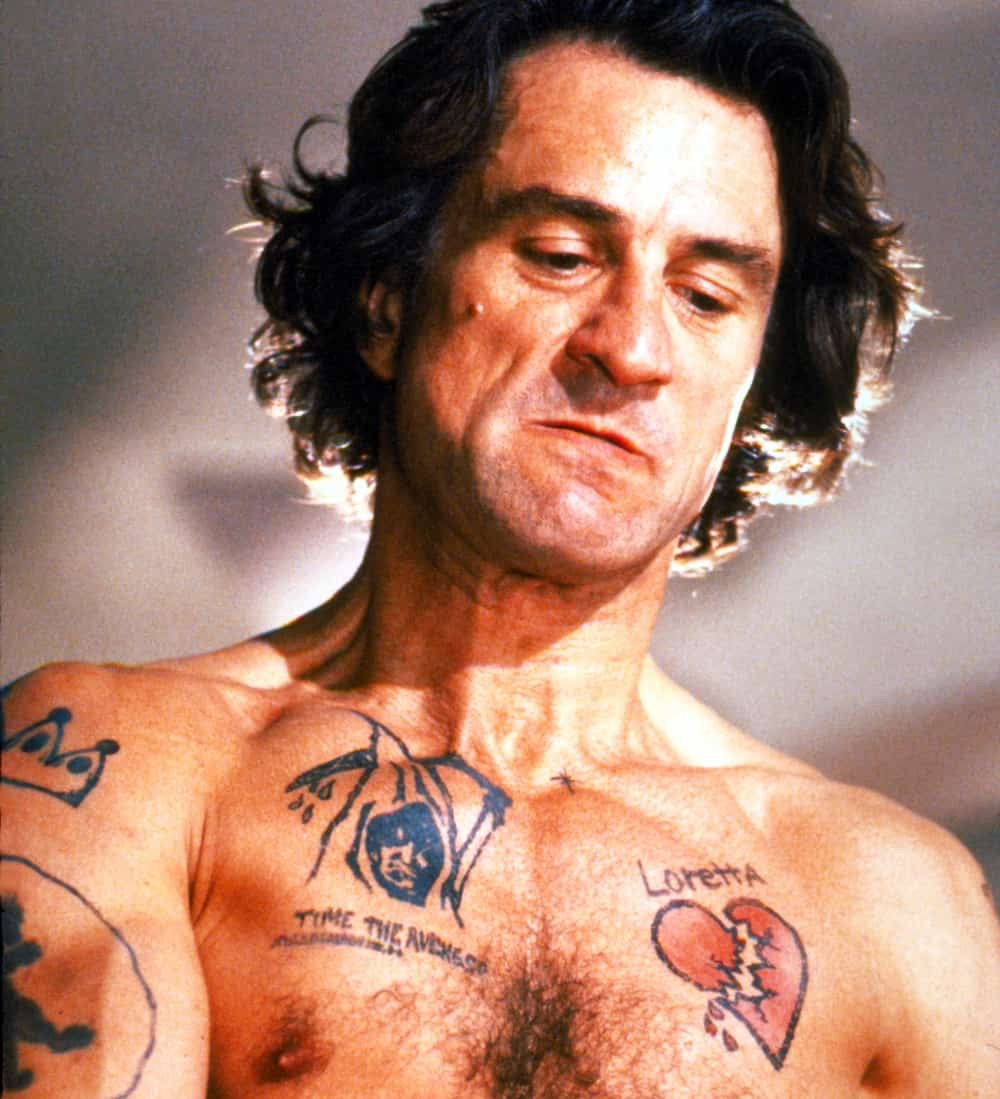De Niro tattoos Cape Fear were instrumental in portraying Max Cady’s menacing character, leaving a lasting impact on how tattoos are perceived in film, and if you’re fascinated by the art of tattooing and its cultural significance, then look no further because tattooat.com offers a wealth of inspiration, expert advice, and a curated directory of talented tattoo artists. Delve into the world of cinematic ink and discover the secrets behind these iconic designs, exploring related terms such as movie tattoos, character transformations, and temporary tattoo artistry.
1. The Impact of De Niro’s Tattoos in Cape Fear
The 1991 remake of Cape Fear, directed by Martin Scorsese, features Robert De Niro as Max Cady, a character whose tattoos are as integral to his persona as his menacing glare. De Niro’s commitment to the role was legendary, extending to his character’s intricate body art, and these tattoos weren’t just superficial additions; they were a deep dive into Cady’s psyche.
1.1. Symbolism and Character Depth
How did the tattoos contribute to the character’s depth?
The tattoos on Max Cady served as visual representations of his twisted worldview, inner demons, and personal history, contributing significantly to the character’s depth and making him all the more chilling. Each design was carefully selected to reflect aspects of Cady’s personality, from his religious fanaticism to his violent tendencies.
1.2. Visual Storytelling
In what way do the tattoos help tell Max Cady’s story without words?
The tattoos told a story without dialogue, giving viewers insight into Cady’s past and motivations, and the ink became a powerful tool for visual storytelling, allowing Scorsese to convey complex ideas and emotions through Cady’s body art.
1.3. Memorable Scene
What impact did De Niro’s tattoos have on the audience?
One memorable scene highlights the impact of De Niro’s tattoos when a sheriff remarks, “I don’t know whether to book him or read him,” underscoring the tattoos’ narrative power and the audience was captivated by the visual spectacle, cementing the film’s place in cinematic history.
2. The Tattoo Design and Creation Process
Creating the tattoos for Cape Fear was a meticulous process, involving collaboration between De Niro, Scorsese, and tattoo artists. Rather than getting permanent tattoos, De Niro opted for temporary designs that would last throughout filming, and Paul Jacobs of Temptu Europa was tasked with bringing these designs to life.
2.1. De Niro’s Involvement
How did Robert De Niro influence the tattoo designs?
De Niro was actively involved in the design process, ensuring that the tattoos aligned with his vision for Max Cady’s character, and he worked closely with the makeup and special effects teams to create a look that was both authentic and impactful.
2.2. Temporary Tattoo Technology
What kind of temporary tattoo technology was used for the film?
Temptu Europa utilized vegetable dyes to create temporary tattoos that could last for months, a significant advancement over traditional methods, and this innovative technology allowed for intricate designs that looked realistic on camera.
2.3. Application and Maintenance
How were the tattoos applied and maintained during filming?
The application process took approximately one and a half hours, with touch-ups as needed to maintain the tattoos’ appearance throughout filming, and the durability of the ink was tested during scenes involving water and fire, proving its resilience.
3. Paul Jacobs and Temptu Europa
Paul Jacobs, an Edinburgh-based tattoo artist, and his company Temptu Europa played a crucial role in creating the temporary tattoos for Cape Fear. Jacobs’ expertise in temporary tattoo technology made him a sought-after artist in Hollywood, and Temptu Europa’s work on Cape Fear brought the company international recognition.
3.1. Early Career and Hollywood Breakthrough
How did Paul Jacobs and Temptu Europa break into the film industry?
Jacobs’ career in Hollywood began with the 1981 film Tattoo, leading to work on other productions like Bird On A Wire and Total Recall, and his company’s breakthrough came with Cape Fear, which showcased their innovative temporary tattoo technology.
3.2. Vegetable Dye Technology
What made Temptu Europa’s temporary tattoos stand out?
Temptu Europa’s use of vegetable dyes resulted in tattoos that lasted much longer than traditional temporary tattoos, providing a realistic and durable option for filmmakers, and this technology allowed for intricate designs that could withstand the rigors of filming.
3.3. Post-Cape Fear Success
How did Cape Fear impact Temptu Europa’s business?
After Cape Fear, Jacobs’ was in high demand, traveling the world to showcase his designs and working on other films like Night And The City and Amos And Andrew, and the film helped establish Temptu Europa as a leader in temporary tattoo artistry for the entertainment industry.
4. The Tattoos Themselves: Designs and Meanings
The tattoos on Max Cady’s body were not random; each design was carefully chosen to reflect his character’s twisted beliefs and violent nature. These tattoos included religious symbols, quotes, and imagery that revealed Cady’s inner demons, and they served as a visual manifestation of his psychological state.
4.1. Religious Imagery
What religious symbols were featured in Cady’s tattoos and what did they represent?
Religious imagery, such as crosses and biblical verses, were prominent in Cady’s tattoos, reflecting his twisted interpretation of Christianity, and these symbols underscored his fanaticism and sense of self-righteousness, adding to his menacing persona.
4.2. Quotes and Inscriptions
What messages were conveyed through the quotes and inscriptions on Cady’s body?
Quotes and inscriptions added layers of meaning to Cady’s tattoos, conveying messages of hate, revenge, and moral superiority, and these words provided insight into his motivations and worldview, making him a more complex and disturbing character.
4.3. Placement and Overall Effect
How did the placement of the tattoos contribute to their overall effect?
The strategic placement of the tattoos on Cady’s body enhanced their impact, drawing attention to specific areas and creating a visually arresting effect, and the tattoos covered his arms, back, and chest, transforming him into a walking canvas of violence and depravity.
5. Tattoo Culture in the Early 1990s
In the early 1990s, tattoos were not as mainstream as they are today. Cape Fear played a role in bringing tattoos to a wider audience, and the film sparked conversations about the art form and its cultural significance.
5.1. Tattoos in Popular Culture
How were tattoos viewed in popular culture before Cape Fear?
Before Cape Fear, tattoos were often associated with marginalized groups, such as sailors, criminals, and outlaws, and the film helped to challenge these stereotypes and bring tattoos into the mainstream.
5.2. Cape Fear‘s Influence
What impact did the film have on the perception of tattoos?
Cape Fear introduced tattoos to a mass audience, sparking conversations about their artistic and cultural value, and the film helped to normalize tattoos and pave the way for their increasing popularity in the years that followed.
5.3. The Tattoo Renaissance
Did the movie contribute to the tattoo renaissance that followed?
The film contributed to the tattoo renaissance of the 1990s, as more people began to embrace tattoos as a form of self-expression, and Jacobs himself hoped that Cape Fear would lead to greater recognition and acceptance of tattoos as an art form.
6. Modern Tattoo Artistry Inspired by Cape Fear
Even today, Cape Fear continues to inspire tattoo artists and enthusiasts alike. The film’s iconic tattoos have been replicated and reinterpreted in countless designs, and it remains a touchstone for those interested in the intersection of film and tattoo art.
6.1. Homage Tattoos
What are some examples of tattoos that pay homage to Cape Fear?
Many tattoo enthusiasts have chosen to get tattoos that pay homage to Cape Fear, replicating Cady’s designs or creating new ones inspired by the film’s themes and imagery, and these tattoos serve as a tribute to the film’s lasting impact on popular culture.
6.2. Influence on Tattoo Styles
How has Cape Fear influenced modern tattoo styles?
Cape Fear has influenced modern tattoo styles by popularizing certain imagery and themes, such as religious iconography and bold lettering, and the film’s tattoos have inspired artists to experiment with different techniques and approaches, pushing the boundaries of the art form.
6.3. Tattoo Culture Today
How has tattoo culture evolved since the release of Cape Fear?
Tattoo culture has evolved significantly since the release of Cape Fear, becoming more mainstream and accepted as a form of self-expression, and tattoos are now seen as a way to celebrate individuality, commemorate important events, and tell personal stories.
7. De Niro’s Personal Tattoo
De Niro himself had a tattoo prior to filming Cape Fear: a blank panther on his upper arm, which he got during the filming of Mean Streets. This tattoo was incorporated into Max Cady’s designs, blurring the line between the actor and his character.
7.1. The Blank Panther
What is the story behind De Niro’s blank panther tattoo?
De Niro’s blank panther tattoo, acquired during the filming of Mean Streets, was a personal piece of ink that he carried into the role of Max Cady, and this tattoo added a layer of authenticity to the character, as it was a real part of De Niro’s identity.
7.2. Incorporation into Cady’s Tattoos
How was De Niro’s tattoo integrated into Max Cady’s designs?
The makeup and special effects teams worked to incorporate De Niro’s blank panther tattoo into Max Cady’s overall design, creating a seamless and cohesive look, and this integration helped to further blur the line between the actor and his character.
7.3. Symbolism of the Panther
What does the panther symbolize in tattoo culture?
The panther is a symbol of strength, courage, and power in tattoo culture, often representing a person’s inner strength and resilience, and in the context of Cape Fear, the panther could be seen as a representation of Cady’s predatory nature.
8. The Enduring Legacy of Cape Fear
Cape Fear remains a classic film, not only for its compelling story and masterful direction, but also for its groundbreaking use of tattoos as a form of character development. The film’s influence can still be seen in modern cinema, with tattoos playing an increasingly important role in visual storytelling.
8.1. Influence on Filmmaking
How has Cape Fear influenced the use of tattoos in filmmaking?
Cape Fear demonstrated the power of tattoos as a tool for character development, inspiring other filmmakers to use body art in creative and meaningful ways, and the film helped to establish tattoos as a legitimate form of visual storytelling in cinema.
8.2. Cultural Impact
What is the cultural impact of Cape Fear?
Cape Fear has had a lasting cultural impact, influencing not only the perception of tattoos but also the way villains are portrayed in film, and the film’s dark and disturbing themes continue to resonate with audiences today.
8.3. Recognition and Awards
Did Cape Fear receive any awards or recognition?
Cape Fear received numerous awards and nominations, including Academy Award nominations for De Niro and Juliette Lewis, recognizing the film’s artistic and technical achievements, and the film’s success helped to solidify its place in cinematic history.
9. Exploring Tattoo Designs and Meanings at tattooat.com
If you’re looking for inspiration for your next tattoo, or simply want to learn more about the art form, tattooat.com is the perfect resource. The website offers a wealth of information on tattoo designs, meanings, and artists, and you can explore different styles, techniques, and cultural traditions.
9.1. Tattoo Design Gallery
What kind of tattoo designs can you find on tattooat.com?
tattooat.com features a vast gallery of tattoo designs, ranging from traditional to contemporary styles, providing inspiration for your next piece of ink, and you can browse by category, keyword, or artist to find the perfect design for your personal taste.
9.2. Tattoo Meanings and Symbolism
Does tattooat.com offer information on the meanings and symbolism behind different designs?
Yes, tattooat.com provides detailed information on the meanings and symbolism behind different tattoo designs, helping you to choose a design that resonates with your personal values and beliefs, and you can learn about the history and cultural significance of various symbols, from ancient tribal designs to modern pop culture icons.
9.3. Finding Tattoo Artists
How can tattooat.com help you find a talented tattoo artist?
tattooat.com features a directory of talented tattoo artists from around the world, allowing you to find an artist whose style and expertise match your vision, and you can browse by location, specialization, or portfolio to find the perfect artist for your next tattoo.
10. The Future of Tattoos in Film
As tattoos become increasingly mainstream, they are likely to play an even more prominent role in film. Filmmakers will continue to explore the power of tattoos as a tool for character development, visual storytelling, and cultural commentary, and the future of tattoos in film is bright, with endless possibilities for creativity and innovation.
10.1. Technological Advancements
How might technological advancements impact the use of tattoos in film?
Technological advancements, such as digital tattoos and augmented reality, could open up new possibilities for the use of tattoos in film, allowing for even more complex and dynamic designs, and filmmakers could use these technologies to create tattoos that change and evolve over time, reflecting the characters’ inner journeys.
10.2. Cultural Representation
How can tattoos be used to promote cultural understanding and representation in film?
Tattoos can be used to promote cultural understanding and representation in film by showcasing the diversity of tattoo traditions around the world, and filmmakers can use tattoos to tell stories about different cultures, communities, and identities, fostering empathy and respect.
10.3. The Art of Transformation
How can tattoos contribute to an actor’s transformation into a character?
Tattoos can play a crucial role in an actor’s transformation into a character, helping them to embody the role both physically and emotionally, and by getting temporary tattoos that reflect the character’s personality and history, actors can fully immerse themselves in the part.
FAQ About De Niro Tattoos Cape Fear
- What was the inspiration behind Max Cady’s tattoos in Cape Fear?
The tattoos were designed to reflect Max Cady’s twisted worldview, religious fanaticism, and violent nature, contributing to his menacing character. - Who designed the tattoos for Robert De Niro in Cape Fear?
Paul Jacobs of Temptu Europa designed and created the temporary tattoos for Robert De Niro in Cape Fear. - Were the tattoos real or temporary in Cape Fear?
The tattoos were temporary, created using vegetable dyes that lasted for months, allowing for intricate designs without permanent commitment. - How long did it take to apply the tattoos to De Niro each day?
The application process took approximately one and a half hours each day, with touch-ups as needed to maintain the tattoos’ appearance throughout filming. - What is the significance of the religious imagery in Max Cady’s tattoos?
The religious imagery reflects Cady’s twisted interpretation of Christianity, underscoring his fanaticism and sense of self-righteousness. - How did Cape Fear influence tattoo culture in the 1990s?
Cape Fear introduced tattoos to a mass audience, sparking conversations about their artistic and cultural value, and helping to normalize tattoos as a form of self-expression. - Did Robert De Niro have any tattoos before filming Cape Fear?
Yes, De Niro had a blank panther tattoo on his upper arm, which was incorporated into Max Cady’s tattoo designs. - How can I find inspiration for my next tattoo at tattooat.com?
tattooat.com offers a vast gallery of tattoo designs, information on tattoo meanings, and a directory of talented tattoo artists to inspire your next piece of ink. - What role do tattoos play in character development in film?
Tattoos can be used to reveal a character’s past, motivations, and personality, adding depth and visual interest to their portrayal. - How has technology influenced the use of tattoos in modern filmmaking?
Technological advancements, such as digital tattoos and augmented reality, offer new possibilities for creating complex and dynamic tattoo designs in film.
Ready to explore the captivating world of tattoos? Visit tattooat.com today and discover a treasure trove of designs, artists, and information to inspire your next ink adventure. Whether you’re a seasoned tattoo enthusiast or a curious newcomer, tattooat.com has everything you need to dive into the art and culture of tattooing, and connect with a community of passionate artists and enthusiasts. Take the next step and unlock your tattoo potential.
Address: 1825 SW Broadway, Portland, OR 97201, United States
Phone: +1 (503) 725-3000
Website: tattooat.com
 Robert De Niro as Max Cady in Cape Fear with prominent tattoos, showcasing the character's menacing persona and the impact of tattoos in cinematic storytelling.
Robert De Niro as Max Cady in Cape Fear with prominent tattoos, showcasing the character's menacing persona and the impact of tattoos in cinematic storytelling.

